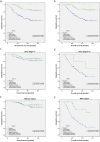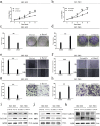Downregulation of homeobox gene Barx2 increases gastric cancer proliferation and metastasis and predicts poor patient outcomes
- PMID: 27533254
- PMCID: PMC5312404
- DOI: 10.18632/oncotarget.11260
Downregulation of homeobox gene Barx2 increases gastric cancer proliferation and metastasis and predicts poor patient outcomes
Abstract
Barx2 is a Bar family homeodomain transcription factor shown to play a critical role in cell adhesion and cytoskeleton remodeling, key processes in carcinogenesis and metastasis. Using quantitative real-time PCR, Western blotting, and immunohistochemistry, we found that Barx2 is expressed at lower levels in human gastric cancer (GC) tissues than in adjacent normal mucosa. In a multivariate analysis, Barx2 expression emerged as an independent prognostic factor for disease-free and overall survival. Kaplan-Meier survival analysis showed a trend toward even shorter overall survival in the patient group with Barx2-negative tumors, independent of advanced UICC stage and tumor relapse. Using in vitro and in vivo assays, we demonstrated that under normal conditions Barx2 inhibited GC cell proliferation and invasiveness through inhibition of the Wnt/β-catenin signaling pathway. These findings indicate that reduction or loss of Barx2 dis-inhibits GC cell proliferation and invasion, and that reduction in Barx2 could serve as an independent prognostic biomarker for poor outcome in GC patients.
Keywords: Barx2; Wnt/β-catenin; gastric cancer; prognosis; progression.
Conflict of interest statement
The authors confirm that there are no conflicts of interest.
Figures







References
-
- Siegel RL, Miller KD, Jemal A. Cancer statistics, 2016. CA Cancer J Clin. 2016;66:7–30. - PubMed
-
- Malvezzi M, Bonifazi M, Bertuccio P, Levi F, La Vecchia C, Decarli A, Negri E. An age-period-cohort analysis of gastric cancer mortality from 1950 to 2007 in Europe. Ann Epidemiol. 2010;20:898–905. - PubMed
-
- Torre LA, Bray F, Siegel RL, Ferlay J, Lortet-Tieulent J, Jemal A. Global cancer statistics, 2012. CA Cancer J Clin. 2015;65:87–108. - PubMed
-
- Bertuccio P, Chatenoud L, Levi F, Praud D, Ferlay J, Negri E, Malvezzi M, La Vecchia C. Recent patterns in gastric cancer: a global overview. Int J Cancer. 2009;125:666–73. - PubMed
-
- Shah MA. Update on metastatic gastric and esophageal cancers. J Clin Oncol. 2015;33:1760–9. - PubMed
MeSH terms
Substances
LinkOut - more resources
Full Text Sources
Other Literature Sources
Medical
Research Materials
Miscellaneous

